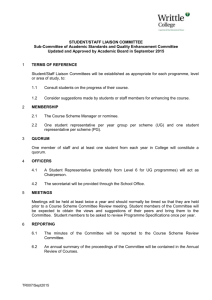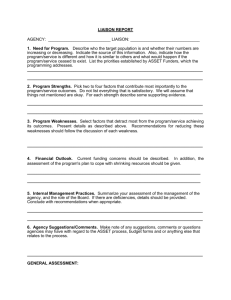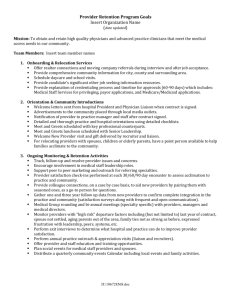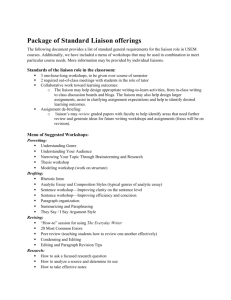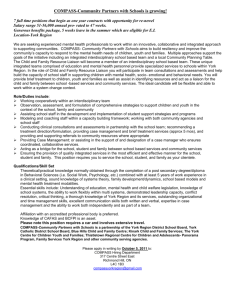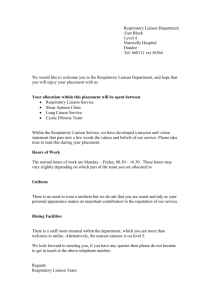View the supporting material
advertisement
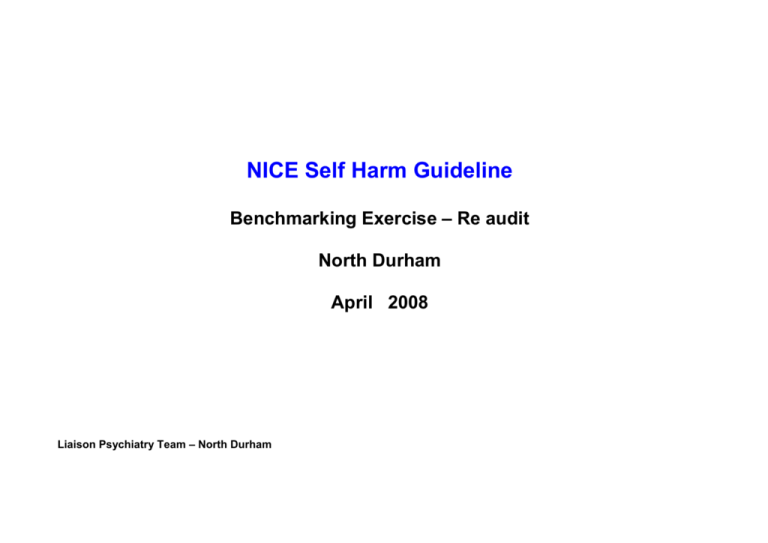
NICE Self Harm Guideline Benchmarking Exercise – Re audit North Durham April 2008 Liaison Psychiatry Team – North Durham NICE Self Harm Guideline Benchmarking Exercise Introduction The NICE Self Harm Guidelines have been developed to advise on the short-term physical and psychological management and secondary prevention of intentional self-harm in primary and secondary care. The guideline recommendations have been by a multi disciplinary group of health professionals, patients and their representatives, and researchers after careful consideration of the best available evidence. In order to implement these it is necessary that services work in partnership and that interfaces with services are clear. Trust Services for People who self Harm The purpose of this document is to re-audit the current provision of self-harm services within Tees, Esk and Wear Valleys NHS Trust provided by the Liaison Psychiatry Service based at University Hospital of North Durham. The initial audit in January 2006 and follow up audit in 2007 benchmarked their service against identified best practice. With the agreement of County Durham and Darlington Acute Hospitals Trust, Accident and Emergency Department at University Hospital of North Durham their service is benchmarked in the section relating to Training issues. Currently Tees Esk and Wear Valleys NHS Trust, Durham and Darlington Foundation Trust, along with representatives from ambulance, police, Primary care trusts, service user groups and non statutory agencies have participated in a national project called the “Better Services for people who Self Harm Collaborative”. The aim of this document is to rate the Liaison Psychiatry team against the NICE Self Harm Guideline, this will help identify action points which will ensuring high quality service delivery in the coming years. For ease of reference we have adopted a traffic light system as an initial way of indicating the current provision of service and related clinical activity RED – no activity in this area AMBER – some activity within this area and partial evidence to support claim GREEN – clear activity within this area and supportive evidence to support claim The targets identified correspond to the National Institute for Clinical Excellence Clinical (2004) Self Harm - Quick Reference Guide, good practice statements. Results Results from initial benchmarking exercise in 2006. January 2007 benchmarking 10 categories have been up graded 5 categories Red to Yellow 4 categories Yellow to Green 1 category Red to Green This demonstrates the progress made to date by the North Durham Liaison Psychiatry Team. However there remain 5 outstanding red areas, some of this work is outside of the remit of the Liaison Psychiatry Team other standards are challenging and require imaginative ways of working. Offering a specialist Liaison service 24/7. Trying to engage service users who self harm to co-facilitate training has been a challenge. Some requires working with other manager’s e.g legal services to provide easy access and develop a protocol. April 2008 Benchmarking 7 categories have been up graded 5 categories from Red to green 1 category from Red to Yellow. 1 category from Yellow to green This demonstrates North Durham’s Liaison Psychiatry teams continued progress, some of this progress needs to be consolidated by audits to evidence the main areas. There are no outstanding red areas, having upgraded all due to Better Services Collaborative and hard work of the liaison staff. The outstanding Red is beyond the remit of the Liaison psychiatry Team as they do not offer prolonged followup. One of the main issues is the lack of availability of Psychosocial assessment for people who self harm 24 hrs a day. This is often outside of the remit for Crisis resolution Home Treatment teams, yet national data has shown that people who self harm attend 09.00 – 17.00 – 30%, 17.00 – 09.00 – 70%. The action points in bold will be used to formulate an action plan working in partnership with the audit department. Functions of Liaison Psychiatry Service in Partnership with A&E UHND Liaison Team Comments A combined physical and mental health triage scale e.g. Australian MH Triage Scale is used 1.2 Able to offer psychosocial assessment at triage to determine Mental Capacity Willingness to remain for further psychosocial assessment Distress levels Presence of mental illness 1.3 Psychosocial assessment available prior to medical treatment (unless the service user needs life saving treatment) As part of the “Better Services for People who self harm” case flow audit completed. Triaged via Manchester Triage tool which place people who self harm in a yellow or above category. Target time of approx 60 mins. A SH Pathway was implemented which includes information from Police and Ambulance service which is given at triage. As part of the A&E pathway document A&E staff document capacity and description of person of there is a likelihood of leaving prior to medical or mental health assessment. Liaison Staff will assess and document mental capacity if necessary within service hours at this point. Operational Policy allows access to MH staff at triage and allows direct referral by A&E staff. Acute staff have to complete a Mental health fast track Checklist. Operational policy allows access to psychosocial assessment following investigations and prior to medical treatment within the working hours and capacity of the Liaison Team from 08.00-17.00 Mondays to Fridays. Audit has been carried out for 24hr through put of Accident and emergency. Outcome was 30% of people attend within the team’s operational hours and 70% outside of operational 1 Statement 1.1 1.4 Safe and supportive environment where people can wait General principles 2 Statement UHND Liaison Team 2.1 Always treat people with care and respect 2.2 Ensure privacy for the service user 2.3 Take full account of likely distress associated with self-harm Choice of male or female staff for assessment, if this is not possible to write in notes and explain to person 2.4 hours. This is in the LDP to extend the service, increase staffing to enable out of hours working has been submitted awaiting outcome. CRHT team provides a limited service into A&E but would not assess prior to medical fitness being confirmed. Yellow score as not available 24 hrs Identified assessment environment in A&E and wards which affords privacy, confidentiality and safety (compliant with RCP guidelines). Brief team audit carried out demonstrating compliance by the Liaison team with this standard. Via Better Services Collaborative the no of completed questionnaires have been poor however results are Question: How do you rate the staff in terms of attitude and respect, service users responded MH staff - Excellent, good, average – 100% MH assessment room identified for Psychosocial assessments. All staff who came into contact with a person who has self harmed need to demonstrate they take full account of the associated distress. Documented evidence to this effect is required Liaison team has a choice of male or female worker. If not NICE guidelines are adhered to by explaining to service users and documenting the reasons why this choice was not possible. Any concerns re this will be 2.5 2.6 Service user given chance to explain in their own words why they have self harmed Involve service user in clinical decision making and provide information about treatment options Relatives, carers and friends 3 Statement reported to Clinical Nurse lead to maintain data for audit purposes. No reported incidents Part of assessment All Liaison staff will discuss MH related treatment and care options and record What information was provided to the person What treatment/care options are available The outcome of the discussion with the person. Service information leaflet given to all service users which has care plan negotiated with service user written on it. The leaflet also gives local help line numbers and liaison service contact details. See Action Plan UHND Liason team 3.1 Include family or friends if the service user wants support through assessment process 3.2 Provide emotional support to relatives / carers if they need it Liaison team will take the service users wishes into account, however initial psychosocial assessment should take place without carer/relative present to maintain confidentiality and allow discussion that pertain to the relationship between service user and carer. This option and outcome should be recorded in the persons notes. Liaison team to offer relative/carer emotional support and help when they need it or whenever possible. A record of this support must be entered within the notes. Consent 4 Statement UHND Liaison team 4.1 Always assess mental capacity and interview relatives / friends to help assessment 4.2 Assume mental capacity unless there is evidence to the contrary Obtain fully informed consent before each treatment or procedure is started (this includes taking the service user to hospital) 4.4 If the service user is mentally incapable, always act in their best interests even if against their wishes (this includes taking the service user to hospital if they have refused) 4.5 Easy access to legal advice about issues relating to capacity and consent at all times 4.3 Liaison Team will document mental capacity as on standard assessment tool. If there are concerns about the persons lack of capacity the team use the agreed capacity form to document their concerns. Relevant information to inform assessment. Liaison Team will always ask the consent of service users to discuss situation with carers/relative/friends and document response in notes Liaison Team will be aware of this guideline and will adhere to it. Competencies via KSF See 4.2 Liaison Staff will be aware of the need to obtain and document consent. Staff to take into account a persons capacity to make informed decisions may change over time. If the person is mentally incapable then the Liaison staff have a “Duty of Care” and responsibility under Mental Capacity act/Mental Health Act, to act in that persons best interests. Staff working with people who self harm should understand how and when the MH act can be used. Staff are aware of how to access legal advice, discussed and minuted at team meeting. Have has 2 teaching sessions re mental capacity Act and how it related to Acute hospital environment. Psychosocial assessment: specialist mental health professionals UHND 5 Statement Liaison Team 5.1 Assess needs and risk as part of the therapeutic process to understand and engage the service user 5.2 Consider integrating needs and risk assessment 5.3 Record assessment in the service users notes 5.4 Share written assessment of need and plan with the service user 5.5 If there is disagreement, consider offering the service user the opportunity to write this in the notes 5.6 Pass assessment onto the service users GP and to any relevant mental health services to enable follow up Assessment of needs 6 Statement 6.1 Offer needs assessment to all people who self harm All staff to be competent in engaging the service user in a therapeutic way, demonstrated competencies via KSF Standardised Self Harm assessment tool includes Main demographic and clinical information has been reviewed via clinical audit. Now one standardised tool across County Durham and Darlington teams All psychosocial assessments should be recorded on the agreed Self Harm assessment tool. Plan is negotiated with service user and shared, the compliance is to be checked via audit See Action Plan Service user is given information about making a complaint and the opportunity to write their concerns on paper which is then filed in case notes. Standard of passing information to GP within 1 working day. Team audit 2007 100% compliance. UHND Liaison Team Agreed target with PCT is 85% people who present to UHND with self harm will have access to a 6.2 Include in the assessment Social, psychological and motivational factors specific to the act of self harm Current intent Hopelessness Mental health and social needs assessment Assessment of risk 7 Statement UHND Liaison Team 7.1 Assess all people who self harm for risk 7.2 Include in the assessment: Main clinical and demographic features known to be associated with risk of further self harm and/or suicide Identification of the key psychological characteristics associated with risk (depression, hopelessness and continuing suicidal intent) Only use standardised risk assessment scale to aid identification of those at high risk of repetition of self harm or suicide 7.3 psychosocial assessment. Audit mechanisms in place reported to PCT on a quarterly basis. Results 2007 are consistently between 95% - 100%. Liaison staff who assesses people in UHND will Use agreed self harm evidence based tool currently in place which incorporates all aspects of this guideline. Full mental health and social needs assessment. All staff new to team will receive training and supervised assessments until competencies are met. Please see 5.2 See 6.1 performance target. All people who self harm and attend A&E at UHND are offered follow up, via telephone or appointment. See 5.2 and 6.2 See 5.2 and 5.3. These will ensure risk assessment scales are not used alone but are available to aid clinical decision making. 7.4 Do not use standardised risk assessment scales to identify service users of supposedly low risk who are not then offered services See 5.3 Referral, admission and discharge following psychosocial assessment (general considerations) 8 Statement 8.1 Base decisions about referral, discharge and admission on comprehensive assessment, including needs and risk Decide jointly with the service user whether to refer for further assessment and/or treatment, or to discharge, where possible If it is not possible to decide options jointly with the service user because of reduced mental capacity or significant mental illness: Explain this to the service user Write the explanation in the notes Consider admission overnight and reassess the following day If the service user is very distressed, has an unsafe home environment and/or it is too difficult to undertake psychosocial assessment, then consider admission overnight and reassess the following day 8.2 8.3 8.4 UHND Liaison Team Liaison staff that assess people following self harm will adhere to this recommendation. This decision will be made in partnership between the service user and the Liaison Staff. All liaison staff will demonstrate competencies in assessment of mental Capacity and identification of significant mental illness via AfC Knowledge and Skills framework. All staff have attended training on Mental capacity act and special teaching session for applying and understanding the Mental capacity act and how it is applied in an acute hospital. This can not only be due to distress or home environment e.g. university Students but also to Drug or alcohol intoxication. There is evidence this recommendation does happen and agreement to admit to A&E Short stay ward has been agreed. This is usually overnight and the liaison team begin at 08.00 to respond quickly to assess these patients. Referral 9 Statement UHND Liaison team 9.1 Discuss treatment options and the service users preference 9.2 Provide the service user with relevant written information about treatments and services 9.3 Do not refer only on the basis that the patient has self harmed Service users should be fully informed of the options available to them and the benefits and disadvantages explored and documented. Through national audit of the Better Services for people who self harm lack of standardised information was an issue. Two leaflets have been produced one specifically for the service see 2.6. The other a standardised self harm information leaflet available in from the Liaison team, Acute Hospitals and North Durham’s GP surgeries. See North and South Durham’s Action plan See 8.1 referral is based on assessed risk and need see sections 6 and 7 Admission 10 Statement 10.1 Consider offering an intensive therapeutic intervention combined with outreach to people who have self harmed and are deemed to be at risk of repetition Intensive intervention should allow greater access to a therapist, home treatment when necessary and telephone contact, and outreach should include following up the UHND Liaison team The Liaison Team can offer up to 3 follow up appointments, but the capacity of the team is such that intensive intervention and outreach is beyond the remit of the team. Home treatment can be offered to people via the Crisis resolution Home Treatment team as appropriate. TEWV Trust need to consider the within the Local development plans for such a service as 10.2 service user when an appointment has been missed. Continued therapeutic intervention plus outreach for at least three months Consider dialectical behaviour therapy for people with borderline personality disorder Don’t, however, ignore other psychological treatments for people with this diagnosis that are outside the scope of the NICE guideline Discharge 11 Statement 11.1 11.2 Decide to discharge a person without follow up based on a combined assessment of needs and risk Do not discharge without follow up solely on the basis of low risk and no mental illness Special issues for older people 12 Statement 12.1 Mental health professionals must be experienced in assessing older adults who have self harmed to recommended by these guidelines. Beyond the remit of the team. In an Audit which followed up referral to secondary mental health services showed that only 25% were followed up for 3 months. DBT is offered by Staff Grade Liaison Psychiatrist in conjunction with Logos Centre. Liaison psychiatry in North Durham are a referrer for Group and Individual Therapy. Short term Cognitive based approaches and solution focused therapy offered by Liaison Psychiatry UHND Liaison Team Evidence of assessment of needs and risk, will reflect the apportioned follow up. Evidence that level of needs and risk assessment is apportioned in the care plan. Agreed pathway and risk assessment tool implemented as part of “Better services for people who self harm” including use of identified risk assessment scale and appropriate action by A&E staff based on level of risk. UHND Liaison team North Durham have an MHSOP Liaison Nurse Consultant, who assesses Self harm in older people. undertake assessment of this age group 12.2 12.3 12.4 Be aware that all acts of self harm in people over the age of 65 years should be taken as evidence of suicidal intent until proven otherwise Always consider admission for mental health assessment, risk and needs assessment, monitoring changes in mental state and levels of risk Follow the same principles as for the assessment of adults, but also include a full assessment with special attention to the possible presence of depression, cognitive impairment, physical ill health and the persons social and home situation Liaison Psychiatry operational Policy states “to encourage admission to acute hospital of older people who self harm. If Adult team do assess in A&E supervision is provided by MHSOP Consultant Psychiatrist. Liaison operational policy as above. Same risk assessment tool is used for older people by Liaison team. Regular risk meetings take place between acute trust, clinical and risk management staff and older peoples nurse and Adult liaison team. Training issues: Managers of services need to ensure that training and support for staff who have contact with people who self harm is available in the following areas 13 Statement 13.1 Clinical and non-clinical staff should be trained in the treatment and management of self harm to equip them to understand and care for service users UHND Liaison team A&E Staff Clinical Adult Liaison Staff receive training and regular supervision weekly every Wednesday supervised by consultant psychiatrists. Staff training is planned with the acute trust 4 sessions in 2008 half 13.2 Staff should receive regular clinical supervision and support 13.3 Staff should be trained in the assessment of mental capacity and issues of consent 13.4 Service users should be involved in the training of staff 13.5 Ambulance staff should receive basic training in mental health assessment as it pertains to self harm day sessions. A&E staff training needs audit has been undertaken as part of the better services for people who self harm collaborative identified the need for training however the uptake for the sessions is poor. SHO Self Harm supervision weekly liaison staff contributes to this. Structured monitoring of Clinical competencies of SHO. Access to Liaison Psychiatrists. Informal staff support available for Acute hospital staff. Pilot revealed limited uptake. All staff have received training in Mental Capacity Act, including acute trust colleagues. Identified service user has agreed to be part of acute hospital sessions Training need analysis has been carried out via Better service for people who self harm. E learning programme to understand self harm and working with people who self harm is to be placed on ambulance intranet. NEAS have agreed to fund self harm 13.6 Emergency departments and mental health services should aim to integrate mental health professionals into emergency departments and provide 24 hour services for people who self harm 13.7 Emergency department staff responsible for triage should have training in mental health triage systems 13.8 Clinical staff involved in the emergency treatment of self-poisoning should be given training to make best use of TOXBASE and the NPIS 14 Statement 14.1 Providing treatment and care for people who have self harmed is emotionally demanding and requires high level of communication, skills and support. All staff undertaking this work should have regular clinical supervision. awareness session these to be agreed as part of the better Services Collaborative Liaison Team service hours 08.00 – 17.00 Monday – Friday excluding bank holidays. Unable to meet target due to time restrictions of service. See 1.1 and 13.1 all received training in Self harm pathway which included triage All A&E staff have access and training on Toxbase. Liaison staff can access through A&E staff. UHND Liaison Team All liaison staff should have formal clinical supervision as per TEWV NHS Trust Clinical Supervision Policy. Weekly meetings supervised by consultants to discuss cases available Debriefing and discussion of case loads should be incorporated into the daily schedule, this should include regular access to Liaison Psychiatrist and Clinical Nurse Lead. Reference: Clinical Excellence Clinical (2004) Clinical Guideline 16 Self Harm:The Short Term physical and psychological management and secondary prevention of self harm in primary and secondary care. Quick Reference Guide. London. NICE. Royal College of psychiatrists (2005) better Services for People who Self Harm Collaborative.
